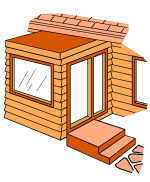Search engine visitors - click here to access entire "$ensible Home" web site
Click here to see a descriptive illustration of several designs vestibules and door threshold seals.
Dear Jim: Our kids are always running in and out. This creates a chilly draft indoors and a lot of dirt. Does it make sense to build a simple vestibule at the door? What type of door threshold weatherstripping is best? - Sue N.

A: Building a door vestibule is an excellent idea and a fun do-it-yourself project. Not only will it cut your utility bills year-round, but it can be attractive and functional. The efficient air lock it creates at the door also blocks noise and the free flow of pollen, molds and dust into your home.
First, before even considering building a vestibule, make sure that your primary door is airtight. The threshold seal (under the door) usually takes the most abuse from children's feet. There are many types of replacement threshold seals to choose from sweep, door shoe, vinyl bulb, automatic retractable, etc.
My favorite threshold seal is an automatic retractable design. When you open your door, the flexible seal at the door bottom automatically lifts slightly. This keeps it from wearing and discoloring your carpeting.
For the easiest and quickest installation, select a retractable design that screws to the indoor face of the door. These are nicely finished and can make an attractive accent to the door bottom. Other non-retractable designs mount under the door and are hidden from view. These require the door bottom to be trimmed.
Once your door is sealed, you must determine the basic vestibule design you want. If you have a roomy foyer or space indoors around the front door, an indoor vestibule is ideal. This space adjacent to a front door is seldom used anyway. You can also build bookcases or shelves into the side of it.
An add-on outdoor vestibule is effective for any door, but especially for a back door. This provides space for muddy shoes and boots to be removed and stored. Install a small bench, coat hooks and some shelves for small garden tools, gloves, hats, etc. I keep my mosquito repellent handy in mine.
The simplest exterior vestibule uses basic 2x4 wall framing and a built-up roof. Install a large pre-hung door. Since the vestibule is not heated, an inexpensive non-insulated door is adequate. Good weatherstripping is imperative.
Install a small window for natural lighting. An inexpensive single-pane window is adequate because the primary purpose of the vestibule is just to create an air lock.
If the window faces south, consider installing a larger thermal window and using foam insulation sheathing. You will be surprised at how warm the vestibule will get. With the large window, it is an excellent spot to start some plants in hanging baskets. When you open the house door, you will feel the warmth.
Instant Download Update Bulletin No. 616 - do-it-yourself instructions for making an outdoor and an indoor vestibule/bookcase with diagrams, dimensions and a required materials list; suppliers of automatic thresholds, door bottoms and weatherstripping, chart of advantages and disadvantages of common types of door threshold seals, do-it-yourself door threshold installation instructions.
Dear Jim: We are building a large wooden deck behind our house. We plan to have several electrical outlets on it. I have heard that ground fault circuit interrupters (GFCI) will not work on a deck? - Sam I.
A: Check your local codes, but I would recommend GFCI's outlets for your deck or any location that may get damp. Even small electrical currents, too small to trip a circuit breaker, can be dangerous.
What you heard about decks and GFCI's is true of a dry deck. Since dry deck lumber is insulated from the ground, there usually is no ground fault. Even if you get between the hot and neutral wires, a GFCI probably will not trip.